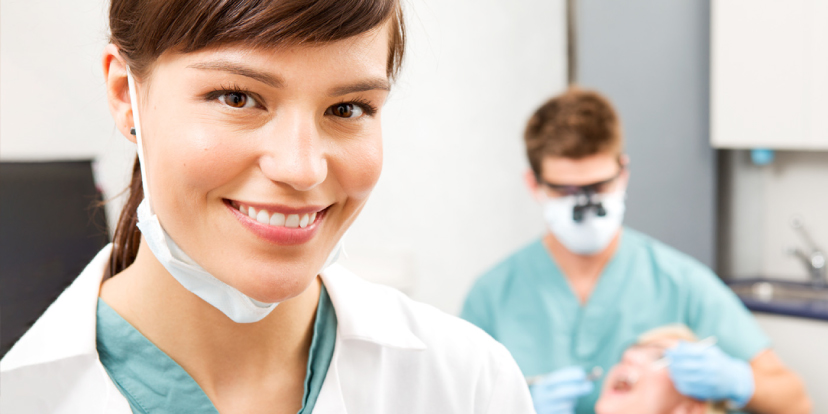Clinical Dental Assistant (Vouchers Included)
- 12 Month
- 300 Hours
- 2,995

Select a section below to view details about the Clinical Dental Assistant program.
Overview
Prepare for the Certified Dental Assistant (CDA) Exam Online
Dental assistants play a valuable role in any dental care team, often handling a variety of tasks from assisting with treatment procedures to administrative duties. This 100% online course will help you gain the technical skills you need to join a dental office as a clinical dental assistant. Upon successful completion of this course, you will receive vouchers to sit for the Anatomy, Morphology, and Physiology (AMP), Infection Control (ICE), and Radiation Health and Safety (RHS) portions of the Dental Assisting National Board examinations.
What you will learn
- Describe the roles for each member of the dental team and twelve dental specialties
- Define the legal and ethical practice of dental assisting, including HIPAA
- Explain deciduous and permanent dentition along with their functions in dental anatomy and pathology
- Describe the chain of infection, transmission routes, and infection control for the dental practice, along with OSHA regulations
- Summarize the role of the dental assistant in pharmacology, nutrition, and interaction with a variety of patients in normal daily activities and emergency situations
- Describe the use, care, and preparation of dental instruments for patient care
- Outline the necessary components of a patient record prior to dental charting
- Use charting techniques to identify dental restorations and disease to create a treatment plan to prevent future disease progression
- Set up equipment for anesthesia and sedation.
- Describe patient clinical methods and techniques to prevent dental disease
- Identify the process of exposing high-quality radiographs in both traditional and digital formats
- Describe dental materials, their uses in dental treatment, and skills needed to use them efficiently
- Define the dental assistant's role in pediatric dentistry, orthodontics, endodontics, prosthodontics, and cosmetic dentistry
- Explain the communication and business needs to maintain a dental business office
- State transferable hard and soft skills in order to complete a resume for a dental assistant position
How you will benefit
- Real-world perspectives from experienced dental assistants
- Essential information about anatomy and physiology, preventive dentistry, patient care, and communication, radiology, pharmacology, anesthesia, assisting in specialty practices, employment strategies, and much more
- Explore the basics of maintaining computerized clinical dental records using Dentrix Practice Management software
Job Outlook for Clinical Dental Assistants
According to the Bureau of Labor Statistics, the average salary of a clinical dental assistant is currently just over $40,000 per year.
Employment is projected to grow by 11% through 2030, which is considered much faster than average. Ongoing research linking good dental health with good overall health is driving this growth as demand for preventative services continues to increase.
Course Objectives
- Real-world perspectives from experienced dental assistants
- Essential information about anatomy and physiology, preventive dentistry, patient care, and communication, radiology, pharmacology, anesthesia, assisting in specialty practices, employment strategies, and much more
- Explore the basics of maintaining computerized clinical dental records using Dentrix Practice Management software
Prerequisites and Requirements
There are no prerequisites to complete this course. However, candidates must have a high school diploma or equivalent to sit for national certification exams.
Curriculum
- I. The Dental Profession
- II. Communication Skills
- III. Ethics for the Dental Assistant
- IV. Basic Dental Sciences
- V. Dental Anatomy
- VI. Oral Pathology
- VII. Infection Control
- VIII. Hazardous Materials
- IX. Caring for Exceptional Patients
- X. Pharmacology for the Dental Assistant
- XI. Emergency Management
- XII. Oral Health and Nutrition
- XIII. The Dental Office
- XIV. Dental Instruments
- XV. Introduction to Chairside Assisting
- XVI. New Patients and Charting
- XVII. Introduction to Dentrix Learning Software (Optional)
- XVIII. Anesthesia and Sedation
- XIX. Preventative Care
- XX. Radiation Health Safety
- XXI. Extraoral and Digital Radiology
- XXII. Dental Emergency Procedures and Amalgam Restorations
- XXIII. Composite Procedures and Laboratory Materials
- XXIV. Pediatric Dentistry and Orthodontics
- XXV. Dental Specialties
- XXVI. Dental Implants and Fixed Prosthetics
- XXVII. Computerized Restorative Systems and Removable Prosthodontics
- XXVIII. Cosmetic Dentistry
- XXIX. Dental Practice Management
- XXX. Your Dental Career
Instructors
Cindy Lamkin
Cindy Lamkin has been employed in the dental field for over 20 years. She graduated from the University of South Dakota with a degree in dental hygiene and holds Registered Dental Assistant and Registered Dental Hygienist credentials. In addition to practicing clinical hygiene, she has also worked in dental office administration and treatment coordination. Her career includes general dentistry, as well as specialty practices of periodontics, endodontics, pedodontics, and orthodontics.
Clinical Dental Assistant FAQs
What does a Clinical Dental Assistant do?
Clinical dental assistant jobs vary based on the dental office and the state your work in. Typical duties include preparing patients for treatment, sterilizing tools, instructing on proper dental hygiene, passing instruments to the dentist during procedures, keeping records of treatments, scheduling appointments and processing x-rays.
How long will it take to become a Clinical Dental Assistant?
Most clinical dental assistant training programs can be completed in one year or less. This does not include the time you will spend working in an externship or similar position to gain experience in the field. It also does not include the required two years of work experience you will need to become certified.
What are the requirements to become a Certified Dental Assistant?
To become a Certified Dental Assistant, you will need to pass the three components of the Dental Assisting National Board (DANB) Certification Exam and meet the Board’s work experience requirements. You will need to pass the Radiation Health and Safety, Infection Control, and General Chairside components of the DANB Certification Exam as well as complete at least two years of work experience (or a minimum of 3,500 hours accrued over a two to four year period).
What kind of hours do Clinical Dental Assistants work?
Most dental assistants work a full-time schedule of 40 hours per week, however there are some dental assistants that work part-time. Many of the hours will be worked during the day, but depending on your dental office, you may be asked to work some evenings or weekends.
Where do Clinical Dental Assistants work?
Almost all clinical dental assistants work in dental offices under the supervision of dentists, though some may find employment with the government or in physicians' offices. Dental assistants work very closely with dental hygienists. In this position, you will be on your feet for large portions of the day and wear surgical masks, safety goggles, gloves, and protective clothing to prevent the spread of infectious diseases.
What is the difference between a Clinical and Administrative Dental Assistant?
While both roles are important components of the dental staff, an administrative dental assistant focuses more on the office's administrative tasks, such as greeting patients, collecting patient information, filling out medical forms, organizing office records, and other clerical tasks. On the other hand, a clinical dental assistant helps dentists and dental hygienists with treatment procedures, sterilization and disinfection of dental tools, patient charting, taking vital signs, processing quality radiographs (x-rays), and more.

